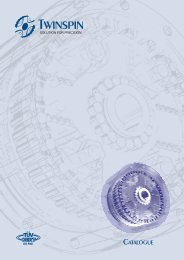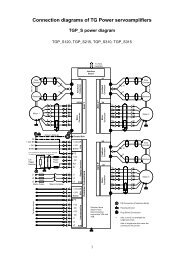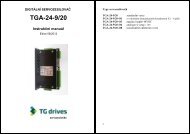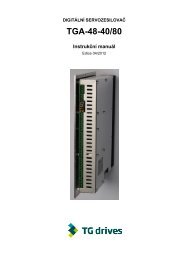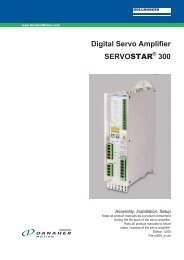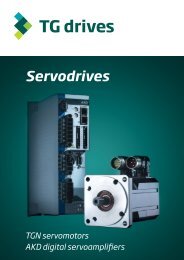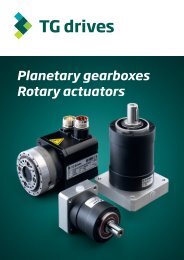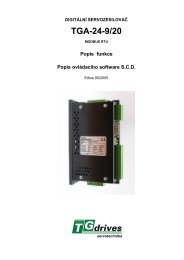Table of Contents - TG Drives
Table of Contents - TG Drives
Table of Contents - TG Drives
Create successful ePaper yourself
Turn your PDF publications into a flip-book with our unique Google optimized e-Paper software.
86<br />
Gear, Electronic gearbox<br />
GEAR, ELECTRONIC GEARBOX<br />
Group Group<br />
No<br />
Gear<br />
GENERAL<br />
EXTENDED REGISTER GROUPS<br />
Gear.In is the number <strong>of</strong> cogs on the input gear and Gear.Out is the number<br />
<strong>of</strong><br />
cogs on the output gear.<br />
Gear.In<br />
Gear.Out<br />
Gear.Speed<br />
Gear.Pos<br />
Description<br />
7 Electronic gearbox. The EN2 is used as master<br />
position input to generate scaled set speed and<br />
position that is added to the set value generated<br />
from the pr<strong>of</strong>ile generator. The position is calculated<br />
as:<br />
OutputPosition := En2-position * InGear / Outgear<br />
The gearbox function makes it possible to set up an electrical gearing between a<br />
DMC 2 and an external position sensor (resolver or encoder) or another DMC 2 .<br />
This gearing can be used for electrical axis applications or for camshaft emulation.<br />
In both cases, the input can be the En2 input (En2.Speed) or an internal constant<br />
frequency <strong>of</strong> 1 kHz. It operates with 1 kHz update rate.<br />
Be aware that if the filter on Rd2 is activated, the source for the gearbox will be<br />
forced as Rd2. To uses EN2 as source, turn <strong>of</strong>f the filter.<br />
GEAR.<br />
In<br />
If > 1 The gains <strong>of</strong> the regulator may have to be reduced by a<br />
GEAR.<br />
Out<br />
corresponding factor because the RD conversion circuit (in the analog system) has<br />
a noise level <strong>of</strong> approx. ±4 increments. If this noise level is amplified by, for<br />
example, a factor <strong>of</strong> 100 due to the gearing, the result would be a very “jumpy” run.<br />
FUNCTION<br />
The number <strong>of</strong> cogs on the input gear.<br />
The number <strong>of</strong> cogs on the output gear.<br />
The input value is multiplied by the ratio Gear.In /Gear.Out.<br />
The result after each sample.<br />
If Gear.In/Gear.Out>1<br />
the Gains <strong>of</strong> the regulator may have to be reduced by a<br />
similar factor because the RD-conversion circuits (that is<br />
an analog system) has a noise level <strong>of</strong> around 4<br />
increments. If this noise level is amplified by, for example,<br />
a factor <strong>of</strong> 100 due to the gearing, the result would be a<br />
very “jumpy” run. When operating in CAM-mode the<br />
Gear.Speed represents the speed <strong>of</strong> the Cam function.<br />
The Gear.Speed value is then added to the sum <strong>of</strong><br />
previous values.<br />
Since this is an incremental function it is possible to<br />
change the ratio during runtime. There is also a ramp<br />
function for smooth activation so that the gearing can be<br />
turned on when the external master is rotating.<br />
The output, Gear.Pos, can also be used as an index<br />
User's Manual 5.1 Inmotion Technologies AB<br />
Doc. No.9032 0027 01 (B), Rev. 11.07.2001



